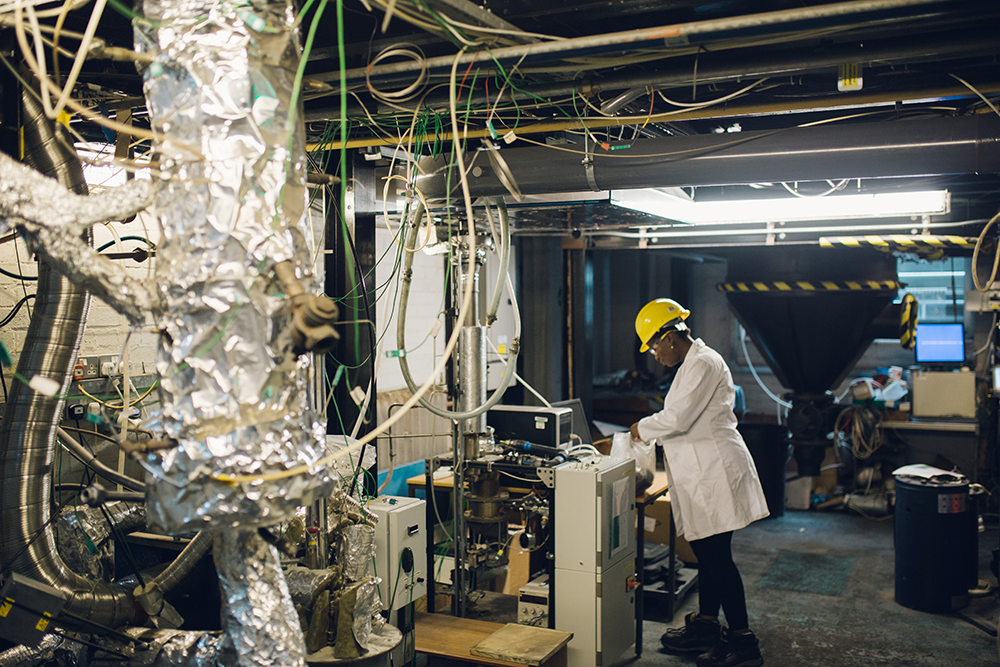What is it like to be a female engineer? International Women in Engineering Day 2018
22/06/2018

STEM is literally a field where ‘things happen’. It is constantly changing and evolving, whether it is discovering a new chemical compound, working on artificial intelligence, developing a novel technology or finding the best route for drug delivery, it has endless opportunities to learn, advance knowledge and solve real problems.
Personally, I am leading the development of a sanitary micro-combustor ― essentially a technology that can convert human faeces to useful end-products such as clean energy, water etc. This system is part of the development of the Nano Membrane Toilet, which is funded by the Bill and Melinda Gates Foundation for people lacking access to modern sanitation. I found the project so interesting and I consider it an amazing opportunity to solve real problems and provide a one-stop solution to environmental, health and energy problems. It also addresses a fundamental problem ― what we consider as waste and the way we utilise and dispose human waste. These are things that appealed to me on my job. Furthermore, I had acquired knowledge on fuel chemistry and combustion processes; it was a great opportunity to apply that knowledge, develop new solutions and to test new technologies — interesting aspects of my work. Working with real faeces maybe not…but it is for a good cause!
Science has always fascinated me, and engineering, though at a later time, has become my newly-found love. I discovered Saccharomyces cerevisae “Baker’s Yeast” could degrade a wooden mat at lower school. I was so fascinated that I decided right there and then to opt for science. It was the basis for which I studied microbiology, and subsequently biotechnology at university. I am a firm believer in applied sciences, that is ‘discovered science should not end as a publication, it should make life better for people and all living things’. This is what caught my interest in engineering and technology.
My Mum, Professor Perciles Pilidis and Dr Eric Goodger have all been major influences on me and my career (and several other people that would be too long to list). Subjects such as physics, chemistry and biology was second nature to me, because I was surrounded by volumes of science books and magazines at home. My mum played a major part in that. She was a community health nurse and worked on several WHO initiatives – setting up new clinics for rural communities, carrying out public health education and awareness and other activities such as disease screening, immunization etc.
I would consider Professor Perciles Pilidis and Dr Eric Goodger as major influencers in my “Tipping Point” for engineering because they looked past my educational background and pushed the boundaries of knowledge by offering me a PhD position at Cranfield University. It’s a rare opportunity, considering the rigidity of the traditional career path, especially in the engineering workspace.
Working in engineering has been quite challenging, especially when people expect those working in the field to have a certain career path. The approach has been “learning backwards”, debunking myths and applying knowledge to push new boundaries. Essentially, it is not all about the taught education that one has acquired, but what one can do with what you have learned and haven’t.
There is a lot of encouragement of girls to study STEM subjects at the moment; however, I believe that the challenge is not getting girls started, but making sure they finish the race. I consider flexible working as an essential element to keep women in STEM industries, especially for those with parental or caring responsibilities. I think policymakers, educators and industry need to make a better connection between STEM subjects and the broader social impact you can have if you work in this area. From personal experience, engineering appealed to me because I saw the opportunity to solve real problems and prospect of improving the lives of people.
Finally, I would say that it is difficult to work in an environment where there are little or no women to aspire and learn from, so having women role models at senior levels can play a major part in encouraging girls and women in STEM disciplines, and in retaining them.
Categories & Tags:
Leave a comment on this post:
You might also like…
Preparing your work for Turnitin submission
Before submitting your work into Turnitin for similarity checking, if you have used referencing software then you may need to take some important steps first. Mendeley and Zotero integrate with MS Word by embedding field ...
The fast track to supercar engineering: My Cranfield journey
It’s been a dream come true to work on some of the world’s most prestigious supercars – the Aston Martin Valhalla, McLaren 750 & Artura, the GMA T.33. But every successful ...
Automotive Engineering: From student to hypercar innovation at Rimac
We sat down with recent graduate Thomas Perrin, to discuss how his year on the MSc in Automotive Engineering at Cranfield University propelled him from the lecture hall directly into the ...
What this year at Cranfield really meant to me
Every Cranfield journey is unique. In this alumni reflection, Zachea Scicluna shares what her year at Cranfield truly meant, from facing uncertainty to gaining hands-on experience in industry-backed projects. I’ve been reflecting (and delaying) ...
Preparing for assignments and exams?
Sorry! We know it seems a bit mean to mention the exams in January rather than looking forward to the break before it! However, we know many of you will be thinking about your forthcoming ...
Screening for FTSE 100 companies on Bloomberg
So you’re researching an index and need some data on its constituent companies? Bloomberg’s Equity Screening tool makes light work of this, not just for the FTSE, but for indices, exchanges and sectors worldwide. Type EQS ...






